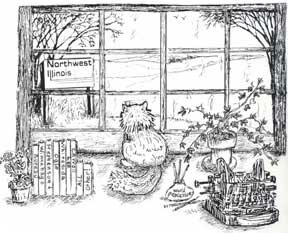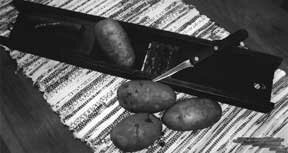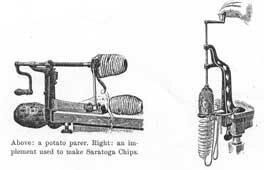
Discover rewarding casino experiences. 
Click on the Flag for More Information |
So was born another method of fixing potatoes. By the mid-nineteen century potatoes were a common, much-used vegetable at the table all meals ... Sliced and fried for breakfast, boiled and mashed for noon dinner, leftovers or fried up with a sausage for supper. It was stick to your ribs. Mashed, boiled, baked, combined with eggs and seasoning. They'd turn into an oven dish ... So versatile is the potato. The sandwich is said to have been first made by the Earl of Sandwich who shoved a piece of meat between two pieces of bread because he didn't want to leave the dice or cards to eat. Oh, come on! A peasant housewife or the serf at the plow would certainly have discovered the ease of a sandwich long before the Earl, just as a matter of necessity and didn't advertise it. Same with the crispy potato which'd be cooked too long at the hearth with the chip being born. Long before Chef Crum, don't you think? Potato chips, in fact, are mentioned as early as the 1830's by cookbook writer, Lydia Maria Child (not Julia, Lydia). In her 1836 edition of "American Frugal Housewife" she stated, "Dedicated to those not afraid of economy ... Take that part of mutton called the rack, cheap food. It is not more than four-to-five cents a pound and will make a dinner for six people. If your family be small a rack of mutton will make two dinners."
Following was how to fix the rack into a "crown" of twelve to sixteen chops. There ensued time, degrees, covering the chop tips so as not to scorch them, etc. Then, into the cavity formed by the crown with its paper frills, fill it with pureed chestnuts (of which there is a recipe) OR potato chips. Chips seems like an odd accompaniment to the mutton, don't they? Whatever. The potato was said to have been "discovered by the Spanish army at the Andean village of Sorocota in 1537, and traveled to Europe after that. Last week's anecdote told how they changed history in several ways. It is believed the potato returned again to this hemisphere, in 1621 when Capt. Nathaniel Butler, governor of Bermuda, sent them to the governor of Virginia. From there it became the most extensively used vegetable in the eventual United States. The size and form of the potato didn't matter much for many year but in recent decades they are grown for specific markets ... A long potato for French Fries, a smaller, round one for uniformity in potato chips, for instance. There are four basic types grown in America as named last week. Forty percent of the potato crops is sold fresh for the table, 31% for fries, yes, 31%; about 13% for chips, nine for dehydrated; six percent for frozen products and the balance for in soup, hash and so forth. Winding up the percentage they are used for potato flour and potato starch. The versatile potato.
As long as we're talking percentages, the Empire State Potato Growers Association established that the average American consumes about ninety-four pounds of potatoes a year, sixteen pounds of that in chips!!! Just look at ourselves in the mirror if you don't believe that. The amount is said to be on the increase! It's pretty easy to see just how popular the potato chip has been by the numbers of metal containers you can pick out in the pictures here. This collection may be seen at the Lena Mercantile, 101 West Railroad Street, an antique/collectible mall. It's that striking pumpkin colored building in downtown Lena. There's a great selection of merchandise, old and new, crafts/homemades and so forth, where six days a week one can find a delicious light menu and many coffee specialties. And while enjoying the cafe respite, look at the potato chip containers in many colors, sizes and company names. The cafe serves those yummy "Mrs. Mike's" chips, a local brand. That company was begun by Mike Noe in Freeport during the Depression years under the brand name, "Always Fresh." Though the name was changed they still are always fresh, being made daily in batches of two to three 1200 pound crates or about 12,000 pounds a week. They are washed and sorted by size and after cleaning are sliced, placed in a cooker where the fat is heated to about 300 degrees. The batch takes about ten minutes to process.
Butch Mordick purchased "Mrs. Mike's" in 1971. It is still located at its long-time site on Monterey Street where you can purchase chips and some of their recently expanded line of products; cheese popcorn and pretzels, a smart choice with Freeport being the "Pretzel City." Other items are for sale there also, tee shirts, etc. and chips in containers from half pound to two hundred that can be sent distances. "Mrs. Mike's" are found at most markets surrounding their home base. Another tasty area brand is "Mrs. Fisher" produced in Rockford. It, too, was named for its origins, Mrs. Fisher, Ethel, in 1932. She and her husband began cooking them in the basement of their home. She sold in 1949, then it was resold in 2007. It remains a big seller using something like 600,000 pounds of potatoes a year. (In a batch of potatoes only about 30% of the weight results in chips.) Other products are distributed by the Fulton street manufacturer and shipped everywhere. "Ole Salty" is another Rockford brand. "Frito-Lay" is Beloit, Wisconsin's largest employer. Kettle Foods, Beloit also, makes gourmet chips. It was recently awarded a gold level certificate for its new factory being a "green building," a 73,000 square foot structure ... Wind turbines and prairie grasses and all. Rice chips are produced by T.H. Foods, Loves Park. C.J. Vitner has the potato chip factory at the south edge of Freeport where you've likely seen a semi tipped on its rear bumper delivering a load of potatoes ... Potatoes on their way to chip Nirvana. What makes all those local chips so tasty? They may be locally grown as well as being locally made. Neumiller Farms between Thomson and Savanna, headquartered at Savanna, is a premier potato grower which contracts with its customers in huge amounts. They have well over four thousand acres in Northwest Illinois; JoDaviess County, Carroll, Whiteside, Rock Island and Mason counties. "Chip" potatoes are harvested earlier than spuds for other uses. Reference gives in July. They are defoliated in their later stages, having been planted in late March-early April. Their "eyes" have sprouted, tuberlike, after three or four weeks. They are fertilized twice during the growing season, according to source. Other varieties are gathered later in the year in the fall. Larger, later potatoes yield about 30,000 pounds per acre. Yield of some varieties may run to 50,000 pounds, those used for salad, mashed or in that best-known of soups, the red and white labeled one! Huge warehouses are carefully layered and layered with some one hundred semi loads in each of taters, carefully so as not to bruise. The storage buildings are cooled and humidified so as to keep the vegetable at its best because customers need the spud year-long. Scheduling, trucking, delivering distances is a big part of the business in which seventy-five acres a day may be harvested. Neumiller Farms began in Wisconsin with Fred Neumiller and family growing vegetables. Son, Tom Neumiller, current president of the family corporation, traveled to Northwest Illinois in the early 1970's and saw some property in JoDaviess County near Hanover which he talked up as acreage on which to expand their operation. In 1974 the Farms expansion into Illinois took place and five years later the Carroll County acreage was added. The other properties purchase ensued. Other crops have been added also ... Corn, Soybeans, Sweet Corn, and so forth. Noted in the separate sources for the different chip and potato companies mentioned here was the fact that most of them were run by families, sold into the family or to an employee who'd become part of a family. Oh, those potatoes must have some sort of pleasing "potato gene" to draw people together, be a most popular vegetable and to have been responsible for changing the course of history through the centuries. Hurrah, the potato!
|







